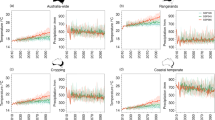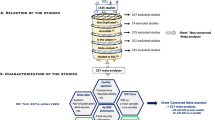Abstract
International initiatives such as the ‘4 per 1000’ are promoting enhanced carbon (C) sequestration in agricultural soils as a way to mitigate greenhouse gas emissions1. However, changes in soil organic C turnover feed back into the nitrogen (N) cycle2, meaning that variation in soil nitrous oxide (N2O) emissions may offset or enhance C sequestration actions3. Here we use a biogeochemistry model on approximately 8,000 soil sampling locations in the European Union4 to quantify the net CO2 equivalent (CO2e) fluxes associated with representative C-mitigating agricultural practices. Practices based on integrated crop residue retention and lower soil disturbance are found to not increase N2O emissions as long as C accumulation continues (until around 2040), thereafter leading to a moderate C sequestration offset mostly below 47% by 2100. The introduction of N-fixing cover crops allowed higher C accumulation over the initial 20 years, but this gain was progressively offset by higher N2O emissions over time. By 2060, around half of the sites became a net source of greenhouse gases. We conclude that significant CO2 mitigation can be achieved in the initial 20–30 years of any C management scheme, but after that N inputs should be controlled through appropriate management.
This is a preview of subscription content, access via your institution
Access options
Access Nature and 54 other Nature Portfolio journals
Get Nature+, our best-value online-access subscription
$29.99 / 30 days
cancel any time
Subscribe to this journal
Receive 12 print issues and online access
$209.00 per year
only $17.42 per issue
Buy this article
- Purchase on Springer Link
- Instant access to full article PDF
Prices may be subject to local taxes which are calculated during checkout



Similar content being viewed by others
References
Paustian, K. et al. Climate-smart soils. Nature 532, 49–57 (2016).
Booth, M. S., Stark, J. M. & Rastetter, E. Controls on nitrogen cycling in terrestrial ecosystems: A synthetic analysis of literature data. Ecol. Monogr. 75, 139–157 (2005).
Liu, L. & Greaver, T. L. A review of nitrogen enrichment effects on three biogenic GHGs: The CO2 sink may be largely offset by stimulated N2O and CH4 emission. Ecol. Lett. 12, 1103–1117 (2009).
Tóth, G., Jones, A. & Montanarella, L. The LUCAS topsoil database and derived information on the regional variability of cropland topsoil properties in the European Union. Environ. Monit. Assess. 185, 7409–7425 (2013).
Lal, R. Beyond COP 21: Potential and challenges of the ‘4 per Thousand’ initiative. J. Soil Water Conserv. 71, 20A–25A (2016).
Decision No 529/2013/EU of the European Parliament and of the Council of 21 May 2013 on Accounting Rules on Greenhouse Gas Emissions and Removals Resulting from Activities Relating to Land Use, Land-Use Change and Forestry and on Information Concerning Actions Relating to those Activities (EU, 2013).
Proposal for a Regulation of the European Parliment and of the Council on the Inclusion of Greenhouse Gas Emissions and Removals from Land Use, Land Use Change and Forestry into the 2030 Climate and Energy Framework and Amending Regulation No 525/2013 of the European Parliament and the Council on a Mechanism for Monitoring and Reporting Greenhouse Gas Emissions and Other Information Relevant to Climate Change (European Commission, 2016).
West, T. O. & Post, W. M. Soil organic carbon sequestration rates by tillage and crop rotation: a global data analysis. Soil Sci. Soc. Am. J. 66, 1930–1946 (2002).
Smith, P. et al. Greenhouse gas mitigation in agriculture. Phil. Trans. R. Soc. Lond. B 363, 789–813 (2008).
Lugato, E., Bampa, F., Panagos, P., Montanarella, L. & Jones, A. Potential carbon sequestration of European arable soils estimated by modelling a comprehensive set of management practices. Glob. Change Biol. 20, 3557–3567 (2014).
Luo, Y., Field, C. B. & Jackson, R. B. Does nitrogen constrain carbon cycling, or does carbon input stimulate nitrogen cycling? Ecology 87, 3–4 (2006).
Reay, D. S. et al. Global agriculture and nitrous oxide emissions. Nat. Clim. Change 2, 410–416 (2012).
Leip, A. Quantitative quality assessment of the greenhouse gas inventory for agriculture in Europe. Clim. Change 103, 245–261 (2010).
Butterbach-Bahl, K., Baggs, E. M., Dannenmann, M., Kiese, R. & Zechmeister-Boltenstern, S. Nitrous oxide emissions from soils: how well do we understand the processes and their controls? Phil. Trans. R. Soc. Lond. B 368, 20130122 (2013).
Leip, A. et al. Estimation of N2O fluxes at the regional scale: data, models, challenges. Curr. Opin. Environ. Sustain 3, 328–338 (2011).
West, T. O. & Six, J. Considering the influence of sequestration duration and carbon saturation on estimates of soil carbon capacity. Clim. Change 80, 25–41 (2007).
Mackey, B. et al. Untangling the confusion around land carbon science and climate change mitigation policy. Nat. Clim. Change 3, 552–557 (2013).
Parton, W. J., Hartman, M., Ojima, D. & Schimel, D. DAYCENT and its land surface submodel: description and testing. Glob. Planet. Change 19, 35–48 (1998).
Grandy, A. S. & Neff, J. C. Molecular C dynamics downstream: The biochemical decomposition sequence and its impact on soil organic matter structure and function. Sci. Total Environ. 404, 297–307 (2008).
Manzoni, S., Jackson, R. B., Trofymow, J. A. & Porporato, A. The global stoichiometry of litter nitrogen mineralization. Science 321, 684–686 (2008).
Van Groenigen, J. W., Velthof, G. L., Oenema, O., Van Groenigen, K. J. & Van Kessel, C. Towards an agronomic assessment of N2O emissions: a case study for arable crops. Eur. J. Soil Sci. 61, 903–913 (2010).
Poeplau, C. & Don, A. Carbon sequestration in agricultural soils via cultivation of cover crops – A meta-analysis. Agric. Ecosyst. Environ. 200, 33–41 (2015).
Lugato, E., Paniagua, L., Jones, A., De Vries, W. & Leip, A. Complementing the topsoil information of the Land Use/Land Cover Area Frame Survey (LUCAS) with modelled N2O emissions. PLoS One 12, e0176111 (2017).
Weier, K. L., Doran, J. W., Power, J. F. & Walters, D. T. Denitrification and the dinitrogen/nitrous oxide ratio as affected by soil water, available carbon, and nitrate. Soil Sci. Soc. Am. J. 57, 66–72 (1993).
Basche, A. D., Miguez, F. E., Kaspar, T. C. & Castellano, M. J. Do cover crops increase or decrease nitrous oxide emissions? A meta-analysis. J. Soil Water Conserv. 69, 471–482 (2014).
Shcherbak, I., Millar, N. & Robertson, G. P. Global metaanalysis of the nonlinear response of soil nitrous oxide (N2O) emissions to fertilizer nitrogen. Proc. Natl Acad. Sci. USA 111, 9199–9204 (2014).
Tonitto, C., David, M. B. & Drinkwater, L. E. Replacing bare fallows with cover crops in fertilizer-intensive cropping systems: A meta-analysis of crop yield and N dynamics. Agric. Ecosyst. Environ. 112, 58–72 (2006).
Tian, H. et al. The terrestrial biosphere as a net source of greenhouse gases to the atmosphere. Nature 531, 225–228 (2016).
Smith, P. et al. Towards an integrated global framework to assess the impacts of land use and management change on soil carbon: current capability and future vision. Glob. Change Biol. 18, 2089–2101 (2012).
Hungate, B. A. Nitrogen and climate change. Science 302, 1512–1513 (2003).
Wieder, W. R., Cleveland, C. C., Smith, W. K. & Todd-Brown, K. Future productivity and carbon storage limited by terrestrial nutrient availability. Nat. Geosci. 8, 441–444 (2015).
Luo, Y. et al. Toward more realistic projections of soil carbon dynamics by Earth system models. in. Glob. Biogeochem. Cycles 30, 40–56 (2016).
Parton, W. J., Stewart, J. W. B. & Cole, C. V. Dynamics of C, N, P and S in grassland soils: a model. Biogeochemistry 5, 109–131 (1988).
Parton, W. J. et al. Generalized model for NOx and N2O emissions from soils. J. Geophys. Res. Atmos. 106, 17403–17419 (2001).
Rawls, W. J., Brakensiek, D. L. & Saxton, K. E. Estimation of soil water properties. Trans. ASAE 25, 1316–1320 (1982).
Hollis, J. M., Hannam, J. & Bellamy, P. H. Empirically-derived pedotransfer functions for predicting bulkdensity in European soils. Eur. J. Soil Sci. 63, 96–109 (2012).
Lugato, E., Panagos, P., Bampa, F., Jones, A. & Montanarella, L. A new baseline of organic carbon stock in European agricultural soils using a modelling approach. Glob Change Biol. 20, 313–326 (2014).
Lugato, E., Paustian, K., Panagos, P., Jones, A. & Borrelli, P. Quantifying the erosion effect on current carbon budget of European agricultural soils at high spatial resolution. Glob Change Biol. 22, 1976–1984 (2016).
Robinson, T. P. et al. Mapping the global distribution of livestock. PLoS One 9, e96084 (2014).
Siebert, S. et al. Development and validation of the global map of irrigation areas. Hydrol. Earth Syst. Sci. 2, 1299–1327 (2005).
Voldoire, A. et al. The CNRM-CM5.1 global climate model: Description and basic evaluation. 40, 2091–2121 (2013).
Simpson, D. et al. The EMEP MSC-W chemical transport model – technical description. Atmos. Chem. Phys. 12, 7825–7865 (2012).
Sacks, W. J., Deryng, D., Foley, J. A. & Ramankutty, N. Crop planting dates: An analysis of global patterns. Glob. Ecol. Biogeogr. 19, 607–620 (2010).
Acknowledgements
The work was carried out as part of the JRC’s Institutional Work Programme under the Natural Capital Soil Project (Project 702), Work Package 5037 ‘Soil for Climate Change’. The LUCAS Survey is undertaken by the EU Statistical Office (EUROSTAT) and supported by the JRC for the soil component.
Author information
Authors and Affiliations
Contributions
E.L. developed the research concepts and conducted the modelling and analyses. E.L., A.L. and A.J. performed the data interpretation. E.L. took the lead on writing the paper with contributions from A.L. and A.J.
Corresponding author
Ethics declarations
Competing interests
The authors declare no competing interests.
Additional information
Publisher’s note: Springer Nature remains neutral with regard to jurisdictional claims in published maps and institutional affiliations.
Supplementary information
Supplementary Information
Supplementary Figures 1–11
Rights and permissions
About this article
Cite this article
Lugato, E., Leip, A. & Jones, A. Mitigation potential of soil carbon management overestimated by neglecting N2O emissions. Nature Clim Change 8, 219–223 (2018). https://doi.org/10.1038/s41558-018-0087-z
Received:
Accepted:
Published:
Issue Date:
DOI: https://doi.org/10.1038/s41558-018-0087-z
This article is cited by
-
Mycorrhiza-mediated recruitment of complete denitrifying Pseudomonas reduces N2O emissions from soil
Microbiome (2023)
-
Counterfactual scenarios reveal historical impact of cropland management on soil organic carbon stocks in the United States
Scientific Reports (2023)
-
A redistribution of nitrogen fertiliser across global croplands can help achieve food security within environmental boundaries
Communications Earth & Environment (2023)
-
A global dataset for the production and usage of cereal residues in the period 1997–2021
Scientific Data (2023)
-
Integrated biochar solutions can achieve carbon-neutral staple crop production
Nature Food (2023)



